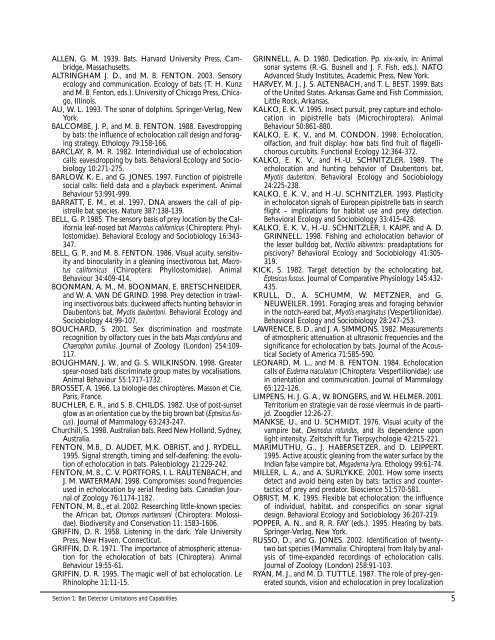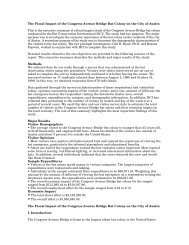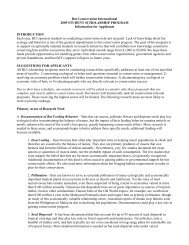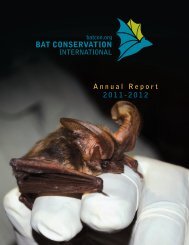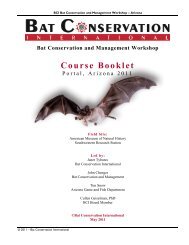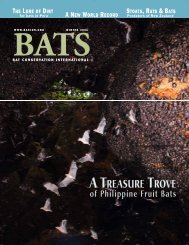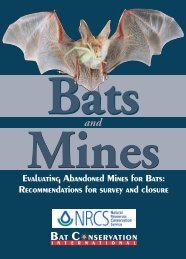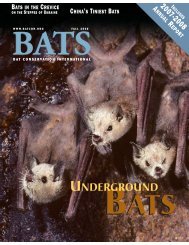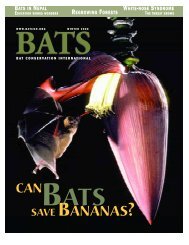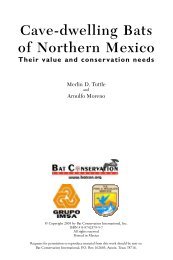Bat Echolocation Researc h - Bat Conservation International
Bat Echolocation Researc h - Bat Conservation International
Bat Echolocation Researc h - Bat Conservation International
Create successful ePaper yourself
Turn your PDF publications into a flip-book with our unique Google optimized e-Paper software.
ALLEN, G. M. 1939. <strong>Bat</strong>s. Harvard University Press, Cambridge,<br />
Massachusetts.<br />
ALTRINGHAM J. D., and M. B. FENTON. 2003. Sensory<br />
ecology and communication. Ecology of bats (T. H. Kunz<br />
and M. B. Fenton, eds.). University of Chicago Press, Chicago,<br />
Illinois.<br />
AU, W. L. 1993. The sonar of dolphins. Springer-Verlag, New<br />
York.<br />
BALCOMBE, J. P., and M. B. FENTON. 1988. Eavesdropping<br />
by bats: the influence of echolocation call design and foraging<br />
strategy. Ethology 79:158-166.<br />
BARCLAY, R. M. R. 1982. Interindividual use of echolocation<br />
calls: eavesdropping by bats. Behavioral Ecology and Sociobiology<br />
10:271-275.<br />
BARLOW, K. E., and G. JONES. 1997. Function of pipistrelle<br />
social calls: field data and a playback experiment. Animal<br />
Behaviour 53:991-999.<br />
BARRATT, E. M., et al. 1997. DNA answers the call of pipistrelle<br />
bat species. Nature 387:138-139.<br />
BELL, G. P. 1985. The sensory basis of prey location by the California<br />
leaf-nosed bat Macrotus californicus (Chiroptera: Phyllostomidae).<br />
Behavioral Ecology and Sociobiology 16:343-<br />
347.<br />
BELL, G. P., and M. B. FENTON. 1986. Visual acuity, sensitivity<br />
and binocularity in a gleaning insectivorous bat, Macrotus<br />
californicus (Chiroptera: Phyllostomidae). Animal<br />
Behaviour 34:409-414.<br />
BOONMAN, A. M., M. BOONMAN, E. BRETSCHNEIDER,<br />
and W. A. VAN DE GRIND. 1998. Prey detection in trawling<br />
insectivorous bats: duckweed affects hunting behavior in<br />
Daubenton’s bat, Myotis daubentoni. Behavioral Ecology and<br />
Sociobiology 44:99-107.<br />
BOUCHARD, S. 2001. Sex discrimination and roostmate<br />
recognition by olfactory cues in the bats Mops condylurus and<br />
Chaerophon pumilus. Journal of Zoology (London) 254:109-<br />
117.<br />
BOUGHMAN, J. W., and G. S. WILKINSON. 1998. Greater<br />
spear-nosed bats discriminate group mates by vocalisations.<br />
Animal Behaviour 55:1717-1732.<br />
BROSSET, A. 1966. La biologie des chiroptères. Masson et Cie,<br />
Paris, France.<br />
BUCHLER, E. R., and S. B. CHILDS. 1982. Use of post-sunset<br />
glow as an orientation cue by the big brown bat (Eptesicus fuscus).<br />
Journal of Mammalogy 63:243-247.<br />
Churchill, S. 1998. Australian bats. Reed New Holland, Sydney,<br />
Australia.<br />
FENTON, M.B., D. AUDET, M.K. OBRIST, and J. RYDELL.<br />
1995. Signal strength, timing and self-deafening: the evolution<br />
of echolocation in bats. Paleobiology 21:229-242.<br />
FENTON, M. B., C. V. PORTFORS, I. L. RAUTENBACH, and<br />
J. M. WATERMAN. 1998. Compromises: sound frequencies<br />
used in echolocation by aerial feeding bats. Canadian Journal<br />
of Zoology 76:1174-1182.<br />
FENTON, M. B., et al. 2002. <strong>Researc</strong>hing little-known species:<br />
the African bat, Otomops martiensseni (Chiroptera: Molossidae).<br />
Biodiversity and <strong>Conservation</strong> 11: 1583-1606.<br />
GRIFFIN, D. R. 1958. Listening in the dark. Yale University<br />
Press, New Haven, Connecticut.<br />
GRIFFIN, D. R. 1971. The importance of atmospheric attenuation<br />
for the echolocation of bats (Chiroptera). Animal<br />
Behaviour 19:55-61.<br />
GRIFFIN, D. R. 1995. The magic well of bat echolocation. Le<br />
Rhinolophe 11:11-15.<br />
GRINNELL, A. D. 1980. Dedication. Pp. xix-xxiv, in: Animal<br />
sonar systems (R.-G. Busnell and J. F. Fish, eds.). NATO<br />
Advanced Study Institutes, Academic Press, New York.<br />
HARVEY, M. J., J. S. ALTENBACH, and T. L. BEST. 1999. <strong>Bat</strong>s<br />
of the United States. Arkansas Game and Fish Commission,<br />
Little Rock, Arkansas.<br />
KALKO, E. K. V. 1995. Insect pursuit, prey capture and echolocation<br />
in pipistrelle bats (Microchiroptera). Animal<br />
Behaviour 50:861-880.<br />
KALKO, E. K. V., and M. CONDON. 1998. <strong>Echolocation</strong>,<br />
olfaction, and fruit display: how bats find fruit of flagellichorous<br />
curcubits. Functional Ecology 12:364-372.<br />
KALKO, E. K. V., and H.-U. SCHNITZLER. 1989. The<br />
echolocation and hunting behavior of Daubenton’s bat,<br />
Myotis daubentoni. Behavioral Ecology and Sociobiology<br />
24:225-238.<br />
KALKO, E. K. V., and H.-U. SCHNITZLER. 1993. Plasticity<br />
in echolocaton signals of European pipistrelle bats in search<br />
flight – implications for habitat use and prey detection.<br />
Behavioral Ecology and Sociobiology 33:415-428.<br />
KALKO, E. K. V., H.-U. SCHNITZLER, I. KAIPF, and A. D.<br />
GRINNELL. 1998. Fishing and echolocation behavior of<br />
the lesser bulldog bat, Noctilio albiventris: preadaptations for<br />
piscivory? Behavioral Ecology and Sociobiology 41:305-<br />
319.<br />
KICK, S. 1982. Target detection by the echolocating bat,<br />
Eptesicus fuscus. Journal of Comparative Physiology 145:432-<br />
435.<br />
KRULL, D., A. SCHUMM, W. METZNER, and G.<br />
NEUWEILER. 1991. Foraging areas and foraging behavior<br />
in the notch-eared bat, Myotis emarginatus (Vespertilionidae).<br />
Behavioral Ecology and Sociobiology 28:247-253.<br />
LAWRENCE, B. D., and J. A. SIMMONS. 1982. Measurements<br />
of atmospheric attenuation at ultrasonic frequencies and the<br />
significance for echolocation by bats. Journal of the Acoustical<br />
Society of America 71:585-590.<br />
LEONARD, M. L., and M. B. FENTON. 1984. <strong>Echolocation</strong><br />
calls of Euderma maculatum (Chiroptera: Vespertilionidae): use<br />
in orientation and communication. Journal of Mammalogy<br />
65:122-126.<br />
LIMPENS, H. J. G. A., W. BONGERS, and W. HELMER. 2001.<br />
Territorium en strategie van de rosse vleermuis in de paartijd.<br />
Zoogdier 12:26-27.<br />
MANKSE, U., and U. SCHMIDT. 1976. Visual acuity of the<br />
vampire bat, Desmodus rotundus, and its dependence upon<br />
light intensity. Zeitschrift fur Tierpsychologie 42:215-221.<br />
MARIMUTHU, G., J. HABERSETZER, and D. LEIPPERT.<br />
1995. Active acoustic gleaning from the water surface by the<br />
Indian false vampire bat, Megaderma lyra. Ethology 99:61-74.<br />
MILLER, L. A., and A. SURLYKKE. 2001. How some insects<br />
detect and avoid being eaten by bats: tactics and countertactics<br />
of prey and predator. Bioscience 51:570-581.<br />
OBRIST, M. K. 1995. Flexible bat echolocation: the influence<br />
of individual, habitat, and conspecifics on sonar signal<br />
design. Behavioral Ecology and Sociobiology 36:207-219.<br />
POPPER, A. N., and R. R. FAY (eds.). 1995. Hearing by bats.<br />
Springer-Verlag, New York.<br />
RUSSO, D., and G. JONES. 2002. Identification of twentytwo<br />
bat species (Mammalia: Chiroptera) from Italy by analysis<br />
of time-expanded recordings of echolocation calls.<br />
Journal of Zoology (London) 258:91-103.<br />
RYAN, M. J., and M. D. TUTTLE. 1987. The role of prey-generated<br />
sounds, vision and echolocation in prey localization<br />
Section 1: <strong>Bat</strong> Detector Limitations and Capabilities<br />
5


